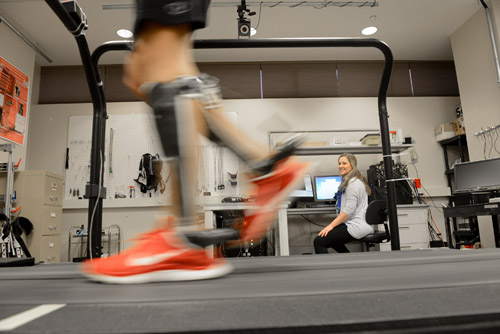Springing Ahead of Nature: Device Increases Walking Efficiency
For Immediate Release
It’s taken millions of years for humans to perfect the art of walking. But research results published today in the journal Nature show that humans can get better “gas mileage” using an unpowered exoskeleton to modify the structure of their ankles. The device puts an extra spring in each human step, reducing metabolic energy consumption by 7 percent below walking in normal athletic shoes.
The finding may benefit both able-bodied people who are frequently on their feet – think of the military infantry or athletic baby-boomers, for example – as well as those who have been victims of stroke or other gait impairments.
To gain an advantage over nature, North Carolina State University and Carnegie Mellon University researchers tested the efficacy of a lightweight lower-leg device that uses a spring and clutch system working in tandem with calf muscles and the Achilles’ tendon while people walk. The streamlined, carbon-fiber device weighs about as much as a normal loafer – around 500 grams, or a bit more than a pound – and is not motorized, so it requires no energy from batteries or other external fuel sources.
“The unpowered exoskeleton is like a catapult. It has a spring that mimics the action of your Achilles’ tendon, and works in parallel with your calf muscles to reduce the load placed upon them,” said Dr. Gregory Sawicki, a biomedical engineer and locomotion physiologist in the joint NC State/University of North Carolina-Chapel Hill Department of Biomedical Engineering who co-authored the paper. “The clutch is essential to engage the spring only while the foot is on the ground, allowing it to store and then release elastic energy. Later it automatically disengages to allow free motion while the foot is in the air.”

The study participants – nine able-bodied adults – strapped the exoskeleton devices on both legs and walked at a normal speed on a treadmill after completing some practice training. The same subjects also walked without exoskeletons for a baseline comparison.
The researchers tested exoskeletons with springs that varied in stiffness. Like Baby Bear’s porridge in the Goldilocks story, the spring that provided the most benefit was moderately stiff. Walking with exoskeletons with springs that were too stiff or too compliant resulted in normal or higher-than-normal energy costs for participants.
“A 7 percent reduction in energy cost is like taking off a 10-pound backpack, which is significant,” Sawicki said. “Though it’s surprising that we were able to achieve this advantage over a system strongly shaped by evolution, this study shows that there’s still a lot to learn about human biomechanics and a seemingly simple behavior like walking.”
“Someday soon we may have simple, lightweight and relatively inexpensive exoskeletons to help us get around, especially if we’ve been slowed down by injury or aging,” said paper co-author Dr. Steven Collins, a mechanical engineer and roboticist from Carnegie Mellon University.
Dr. Bruce Wiggin, a former NC State graduate student, co-authored the paper. Funding was provided by grants to Sawicki from the NC State Faculty Research and Professional Development Fund; the NC State Chancellors Innovation Fund; Grant No. 2011152 from the U.S.-Israel Binational Science Foundation; and Award Number R01NR014756 from the National Institute of Nursing Research of the National Institutes of Health. It was also supported by the National Science Foundation under Grant No. IIS-1355716 to Collins.
– kulikowski –
“Reducing the energy cost of human walking using an unpowered exoskelton”
Authors: Steven Collins, Carnegie Mellon University; M.B. Wiggin and Gregory S. Sawicki, North Carolina State University
Published: April 1, 2015, in Nature
DOI: 10.1038/nature14288
Abstract: With efficiencies derived from evolution, growth and learning, humans are very well-tuned for locomotion. Metabolic energy used during walking can be partially replaced by power input from an exoskeleton, but is it possible to reduce metabolic rate without providing an additional energy source? This would require an improvement in the efficiency of the human-machine system as a whole, and would be remarkable given the apparent optimality of human gait. Here we show that the metabolic rate of human walking can be reduced by an unpowered ankle exoskeleton. We built a lightweight elastic device that acts in parallel with the user’s calf muscles, off-loading muscle force and thereby reducing the metabolic energy consumed in contractions. The device uses a mechanical clutch to hold a spring as it is stretched and relaxed by ankle movements when the foot is on the ground, helping to fulfill one function of the calf muscles and Achilles tendon. Unlike muscles, however, the clutch sustains force passively. The exoskeleton consumes no chemical or electrical energy and delivers no net positive mechanical work, yet reduces the metabolic cost of walking by 7.2 ± 2.6% for healthy human users under natural conditions, comparable to savings with powered devices. Improving upon walking economy in this way is analogous to altering the structure of the body such that it is more energy-effective at walking. While strong natural pressures have already shaped human locomotion, improvements in efficiency are still possible. Much remains to be learned about this seemingly simple behavior.
- Categories:


